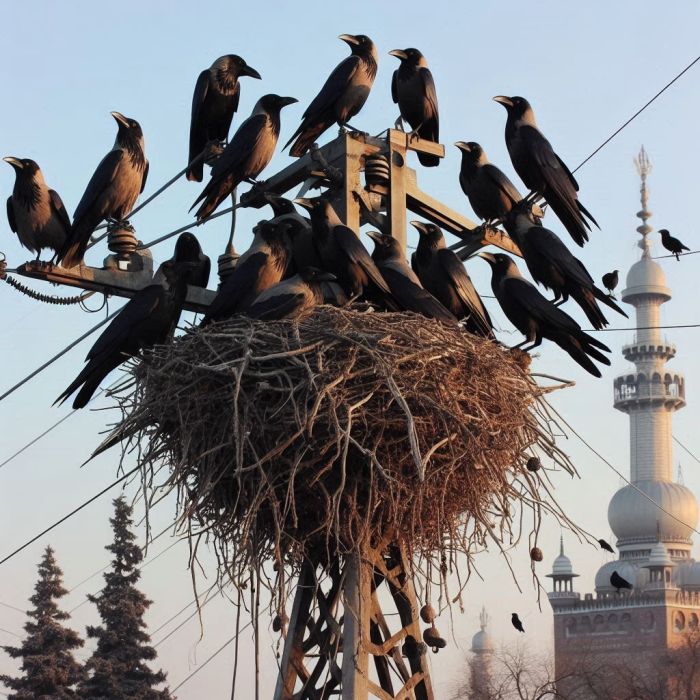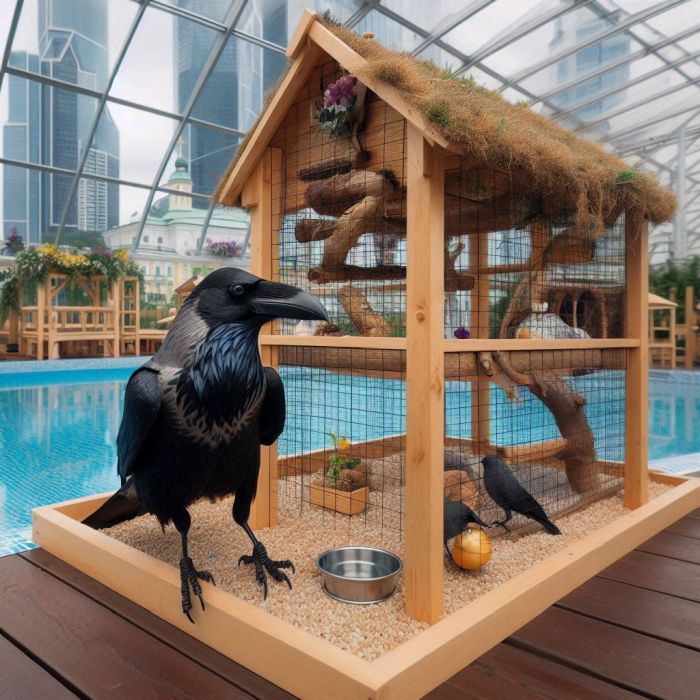
Raven and crow: interesting facts – they are different birds and both species are very intelligent.
Raven, common raven (Corvus corax) – a bird of the raven genus is widespread in Europe, Asia and North America. They live in lowland and mountain forests, river floodplains, deciduous forests.
The black crow (Corvus corone) is a species or subspecies of birds of the raven genus (Corvus). Often the black and gray crows are considered subspecies of the same species, in which case the black crow is called Corvus corone corone and the gray one is Corvus corone cornix. The plumage is black. Its range consists of two unrelated parts. It is widespread in the west of Europe and in Asia.
A raven is an omnivorous bird. He is the largest representative of his kind. It has a remarkable appearance: it is completely black, has a strong beak and a significant size. The length of crows can reach 70 cm, the wingspan is up to 150 cm. Weight of a crow is usually 1-2 kg, males are slightly larger than females.
The common raven can be found in almost any environment. In forests and forest-steppes, on the sea coast, in a meadow, in the tundra and desert. They get along well with people, especially in rural areas, but they also live in some cities.
- 1 Interesting facts: how long do raven and crow live
- 2 These two species belong to the Corvidae family.
- 3 What do raven and crow eat?
- 4 Raven and crow: interesting facts reproduction and offspring
- 5 Omens and superstitions about crows
- 6 Interesting facts: the relationship of raven and crow to people
- 7 Crows can mimic sounds and memorize words.
- 8 Maintenance at home
Interesting facts: how long do raven and crow live
There is a belief that crows (ravens) can live up to 300 years, but it is not true. Usually, ravens live 10-15 years in the wild, and in captivity, with good care, they can live longer. An example is the well-known tower ravens (ravens). The maximum lifespan of a raven living in the London fortress reached 40 years.
The crow lives less: in the wild up to 13 years. In captivity – up to 20 years.
Yes, ravens (ravens) and ravens (ravens) are different birds.
Raven (crow) and ravens are the closest relatives.
These two species belong to the Corvidae family.
First of all, they differ from each other in size and sounds, with the help of which they communicate with each other.

The raven (crow) is larger in size, the raven is much smaller – its body size can be compared to a large pigeon. You can also tell a crow from a crow by listening to the sounds they make. The raven is known for its simple and loud cawing, while the raven makes a deeper, guttural cawing sound.
In addition, upon closer inspection, you can see that ravens have fluffier feathers around their heads, especially on their throats. A crow’s beak is thicker and has a large curve at the end. During the flight, you should pay attention to the bird’s tail. Crows have tail feathers of the same length, so their tail looks like a fan. The raven differs in different lengths of tail feathers, so its tail has a wedge-shaped or diamond-shaped shape.
These birds also have a different flight style. A raven (raven) soars in the sky, and a raven flaps its wings. The difference between these species can be noticed even when walking on the ground. Crows usually just walk on the ground, and a raven (raven) walks and jumps.
What do raven and crow eat?
The crow eats everything it comes across – from insects, rodents and other birds to cereals, berries, vegetables and fruits. Crows will not refuse both carrion and food waste. In general, this large bird is able to catch even a hare or a small ungulate.
When getting food, the crow shows amazing intelligence. For example, watching a fox that steals goose eggs, it remembers where it hid the prey. Then he steals those eggs. There were even cases when a raven led wolves to a herd of deer or elk, and then followed the predators to eat the remains of the animals.
Raven and crow: interesting facts reproduction and offspring
Crows are monogamous birds, living mainly in pairs. Pairs last for many years, sometimes for a lifetime. The mating season of crows begins at the end of winter. The mating games in the air, with the birds circling and chasing each other, begin very early in February and even as late as January. A crow can also make an impression on a female due to a dignified gait. The bird raises its head high, inflates its neck, spreads its tail with a fan and walks in front of the female in this form. If a couple has formed, the crows clean each other’s feathers.
Crows like to build their nests very high – on the tops of trees, towers, poles of power lines, and even on lighthouses. A male and a female take part in creating a nest. Twigs, hay, wool and other materials are used as construction material. A crow’s nest can be quite large – up to 1.5 m in diameter. As a rule, a family of crows will give birth to not one, but several nests in a small area, and use them in turn.

Crows have from 1 to 8 eggs in a nest. 4-8 eggs are most common. Usually the female incubates the eggs, while the male gets food. Two weeks after the chicks hatch, the female also begins to look for food. Chicks can already stay in the nest by themselves. Crow chicks begin to fly after four weeks, but can live with their parents for several months. Young crows leave the family in winter, and sexual maturity occurs at 2-30 years of age.
Ravens (ravens) are very useful birds that destroy many harmful insects and rodents, and also perform sanitary functions in nature. They deserve complete and thorough protection.
Omens and superstitions about crows
A lot of folk signs and superstitions are associated with crows – both positive and not so good. One of the most common omens is the cawing of a crow predicts trouble, especially if a person is nearby. In addition, it is strictly forbidden to kill a raven (raven) or a raven – in ancient times it was believed that by such an act a person cursed himself and his family. And the majority of positive signs are associated with a pair of ravens – no wonder, because they embody strong and long relationships. Even seeing two ravens together was considered a sign of a quick wedding. If a bird family happens to attend a wedding, it was considered a sign of a long and happy married life.
Interesting facts: the relationship of raven and crow to people
Wild crows are wary of people, but they are not afraid of them at all. This bird likes to observe human behavior. Crows in captivity are very friendly with their owners, devoted to them, and can even be jealous of a person for his household or other animals.
Ravens are one of the smartest animals, so there are many interesting facts about them.
The bird got its name because of the color of its feathers – “voronoi” means black in Old Slavic.
Crows are able to remember people who have tried to harm or frighten them.
Raven can perform aerobatics – barrel, half-barrel.
Crows can play games with each other. For example, take turns picking up a pebble in their beaks until someone drops it.
In the winter, crows can skate on the snow as entertainment.
Crows can throw hard nuts under the wheels of cars to crush them.
Crows can mimic sounds and memorize words.
Raven has patience. If waiting before making a decision can do more than any action, he will wait.
Crows have gestures that attract the attention of other birds. They take an object in their beak and show it to other crows. In the first moment, attention is drawn to the object. But then contact is established with the raven itself, which gives the sign.
When scientists decided to test whether the crow was truly intelligent. The birds were given water to drink from a deep pitcher that the crow could not reach with its beak. The experimental crow guessed to throw various objects into the jug to raise the water level.
If you give a crow solid food, say a cracker, and there will be water near it, it will first take the cracker, soak it in water, and only then eat it.

Maintenance at home
To keep a crow at home, special conditions are required. A bird needs space – preferably a large, bright aviary with a feeder, a drinker, and a place to bathe. At the same time, the crow should be walked as long as possible, but at least several hours a day. Since crows are omnivores, there should be no problems with food. Meat, cereals, eggs, berries, vegetables and fruits should be included in the bird’s diet.
Read also: